Starting Goat Farming Made Simple – Profitable Business Plan

If you are on the lookout for ways to earn easy and quick profits, you might think of small businesses that demand minimal investments, but earn high gains. Goat farming business is one of them and you can start easily with very minimal investment.
You should have solid business plan before starting goat farming as a business. In this article we have crafted easy to understand business planning tips for you.
Goat farming is popular all over the world including USA, UK, India, Pakistan, Bangladesh and in African countries.
In this article, we are going to share useful information and business plan samples for beginners on how to start, run and grow a commercial goat farming project anywhere in India.
Opportunities in Goat Farming as a Business
As you know that goat milk and meat are popular across the globe. This is because there are several breeds that serve as excellent quality meat, such as Black Bengal, Boer, Matou, etc.
Also, goat milk is better digestible than cow’s milk and rich in nutrients. Breeds, such as Jamunapari, Black Bengal, Sirohi etc are very useful for this purpose.
A few breeds have smooth and good quality skins. They include Maradi, Black Bengal, etc. These skins sell in both local and international marketplaces for a good price.
The Angora and Cashmere breeds produce top quality wool.
You can also sell goat’s droppings as organic fertilizer with no chemicals to farmers.
As you can see that there are ample opportunities in goat farming as a business. You can sell everything in local and international market.
How to Start Commercial Goat Farming – Business Plan
1. Selecting Profitable Breeds
First thing you should understand that the selection of breed is very important in goat farming business. You should not make any mistakes in goat breeds selection. You can have only a few breeds on your farm which will produce good result.
Below are few important points you should consider for breeds selection:-
- Prior to purchasing breeds you have to decide what you want from your business first; whether milk or meat.
- Pure breeds flourish in particular climatic conditions.
- Sirohi loves the dry and hot weather of Rajasthan in India.
- If you wish to keep it in another part of the country, you have to find a crossbreed, like the progeny of a Sirohi male and a Black Bengal female.
- You should request professional help in selecting your ‘goat’ breeds.
- Visit your nearest goat farm and understand the basics of goat breeds selection.
Decide how many males and females you want to breed on your farm. Goats are categorised as uncastrated males or bucks, castrated males or wethers and females or does. You can have both kids and adults on your farm and any number of breeds as you can afford.
2. Understand Basics of Goat Shed Construction
There are no set of rules for the selection of land. You can go ahead with whatever you have, as long as it has some greenery in it. A healthy grazing area is all you require for your goats.
Make sure that there is enough space for housing your goats and their caretakers. The caretakers have to be there 24 x 7 x 365.
It is better if your farm is on the outskirts of the town/city, so your goats will be able to live in peace! Wherever the location of the farm is, you need a well-defined boundary.
You have to fence with bamboo sticks, which should not prove too costly. You can also put up a brick-and-cement wall with a gate, so that your goats can have greater security from wild animals and thieves.
3. Goat Shed Construction Plan
You cannot just leave your goats in the open all the time, and forget all about them! You have to offer them a secure, spacious, clean, well-sanitized and hygienic shed.
- The dimensions of the shed will depend upon the land area you have, the money you are going to spend and the number of goats in the farm.
- If you plan to have 100 goats, you must have a shed measuring 60-70 feet length x 18-20 feet width.
- Every goat needs to have a minimum of about 10 square feet to call its own.
- Make sure you use bricks and cement for constructing the walls of the shed.
- The walls should be high, for the goats require proper ventilation with windows.
- Depending upon the climatic conditions in your region, you can choose a roof constructed from asbestos that absorbs heat or bricks-and-cement is better.
- Having built a shed for the goats; they need a yard too, for grazing. Place a bamboo fence around the shed, leaving sufficient space for the goats to take morning and evening walks!
- At one side, construct a cement water tank or a water reservoir. Keep this filled with fresh drinking water always. A bore well, with a submersible pump or motor, to provide fresh drinking water if you can’t get tap water.
- Your goats require feeding stalls too. Build the stall from cement, when placing it inside the shed. Make it from steel menzer, when placing it outside the shed.
4. Fodder for the Goats
Your goats need nutrient-rich food, in order to grow well.
Newborn kids must drink mother’s milk for two to three months at least. The colostrum in the milk builds up their immunity.
Ten to twelve days after their birth, give them supplementary special kid feed as mother’s milk will not be enough.
Kid goats relish maize and lucerne or any green fodder.
Adult goats enjoy feeding on the richly green leaves of Pangara, Subabul, Anjan, Sheyari and Babul beans.
If you plan for complete stall-feeding, then make sure that your goats get a couple of kilograms of dry fodder, 3 to 4 kg of green fodder and around 200 to 250 grams of seeds concentrates readily available from shops.
If your goats will stall feed for some time and engage in free grazing the rest of the time, then divide the above-mentioned quantities into half-and-half.
No matter what you feed them, your goats must be able to graze naturally too.
Their digestive systems function properly and their metabolism remains intact only through natural grazing.
5. Preparation of Silage
If you have the patience,you can go for making silage from green fodder. It will help your goats consume high-quality fodder even during the lean season when there is no green pastures available for grazing.
- Silage refers to the production of soft, moist, fruity and green material produced from green fodder to be preserved like pickles.
- Bajra or pearl millets, maize, jowar or sorghum, etc, are rich in carbohydrates or soluble sugars.
- Cereal fodders or grasses and legumes at the ratio of 3:1 are good too, same as dry forage and unwilted leguminous leafy fodders at the ratio of 1:4m.
You will need a silo or a pit for preparing silage
Just dig a pit, which is anywhere between 2.5 to 3.0 meters deep. It would be best to have it dug on elevated ground. Make sure there is enough space for the fodder to go in comfortably.
Estimate how much feed your goats will require based on their numbers and the duration of feeding. Line the walls with mortar, brick or cement, for water must not enter the silo.
If you have selected the crop that you would like to ensile and conserve the green fodder, you may begin the process of preparing silage. Make sure that the weather is not humid or wet.
- Does your selected crop have 30% to 35% of dry stuff? If not, allow it to dry for a few hours.
- You may fill the silo with long fodder too, yet, choose chaffed/chopped fodder.
- You will be able to preserve the nutrients better,and also fill and remove silage easily.
- If you add urea at 1% and salt at 0.5% to grasses and cereals, the nitrogen content and palatability may be improved.
- Does your selected crop have 30% to 35% of dry stuff? If not, allow it to dry for a few hours.
- You may fill the silo with long fodder too, yet, choose chaffed/chopped fodder.
- You will be able to preserve the nutrients better,and also fill and remove silage easily.
- If you add urea at 1% and salt at 0.5% to grasses and cereals, the nitrogen content and palatability may be improved.
When legumes and grasses go into conserving ensiling of green fodder, we refer to it as haylage. When we use organic wastes like bovine dung, poultry droppings or litter, swine excreta, etc., for ensiling, we call it wastelage.
Excellent silage will exhibit an acidic odor and taste, a pH between 3.5 and 4.2, lactic acid content of 1-2% and ammoniacal nitrogen being less than 10% of the total nitrogen. There is also the absence of sliminess, butyric acid and moulds.
Good silage will have acidic odor and taste, pH between 4.2 and 4.5, traces of butyric acid and ammoniacal nitrogen going up to 10% or 15% of the total nitrogen.
Fair silage will show the presence of moulds, butyric acid, ammoniacal nitrogen 20% of the total nitrogen and a pH of 4.8.
6. Important Nutrients
While the rumen has good microbes for synthesizing other vitamins, goats require vitamins E, A and D from external sources. Vitamin A is present in yellow maize and green foliage. Vitamins D and E are available as supplements.
With regard to kids, you may feed them with Terramycin or Aureomycin antibiotics for improving their general appearance and keeping infectious diseases at bay.
Goats consume higher amounts of feed than sheep or cattle do, especially in the form of dry forage. They also have a higher basal metabolic rate.
If your goats must have strong bones and skeletons, healthy functioning of organ systems and the females producing large quantities of milk, they need phosphorus and calcium.
Phosphorus should be 3.5 g/50 kg of body weight.
Calcium should be 6.5 g/50 kg of body weight.
Hang up lumps of salt at suitable places in the shed. Licking salt helps the goats to have well-toned systems, and even helps remove worms from their bodies.
Based upon the weight of the female goat and how much milk it can produce, it can do so only if it gets a balanced diet.
7. Vaccination is Very Important
Goats are prone to various diseases, such as Foot and Mouth (FMD) disease, contagious pneumonia, Anthrax, etc. Therefore, they need a vaccination schedule. Some of the common vaccinations include –
- Once a year dosage for FMD either in February or December.
- Annual vaccination for Anthrax either in May or June.
- IVRI/CCPP vaccine once a year.
- Annual vaccination for Enterotoxemia in May or June
- The PPR vaccine is due once every three years.
It would be best to consult a veterinarian and decide what is best for your goats.
8. Risk Factors in Goat Farming
Since you are dealing with living creatures, you will always face some risks too, in your goat farming business.
Mortality Rate
You will have to make sure that the surroundings are extremely hygienic, vaccinations are given in time, and food is uncontaminated to avoid dead goats.
Drinking water must be fresh. Keen vigilance and proper feeding are the keys to keeping the mortality rate down.
Provide kids with an electric room heater in cold conditions. Allow them to drink mother’s milk, to build up immunity.
Fencing
High and strong boundaries are necessary, if you want your goats to be safe from thieves and wild animals. You will have to make a head count everyday to see if a goat is missing.
Infections and Diseases
Goats are more prone to contagious diseases. You must be careful in identifying sick animals and keeping them in isolation sheds.
High Feeding Costs
It would not be wise to compromise on the percentage of concentrate in the food. Instead, allow them to graze naturally as often as possible if you want to save on food.
You may try the Hydroponic System of fodder production. Seeds are placed in Hydroponic trays and water sprinkled on them at timely intervals. When they germinate you can place them in hooes made in PVC pipes with flowing water from fish tanks.
You gain complete and detailed knowledge about the lengthy process of aquaponics from an expert and also on YouTube.
Marketing
There are specific markets, with a high demand of goats, in comparison to others. Also, keep track of festivals, for the demand is more on such days.
There are pros and cons to every business venture. Do not allow the ‘cons’ to scare you off the profitable goat farming business.
FAQs
You need a minimum of an acre of land for a small herd of goats.
Depending on where you live, the costs of starting a goat farm can vary. You need to account for buying goats, building shelters, and buying feed. Costs can range from a few thousand to several thousand dollars.
Generally, goats are considered less expensive to keep than other livestock.
Dairy breeds of goats include Alpine, Nubian, Saanen, Toggenburg, American Oberhasli, and LaMancha.
Goats are browsers, not grazers, so they prefer to eat a variety of different plants. They eat hay, grain, and fresh vegetables.
Goats need adequate space to be healthy and happy. A single adult goat typically needs around 10-15 square feet of space.
Yes, goats need access to fresh, clean water at all times.
Goats need to be groomed at least once a week to keep their coats clean and free of debris.
Goats need to be vaccinated regularly against common diseases. Talk to your local veterinarian for specific recommendations.
The average goat produces around 2 gallons of milk per day, though this can depend on breed, age, and health.






